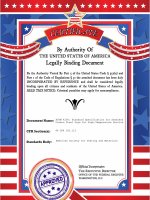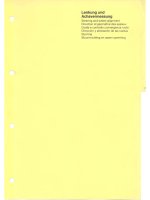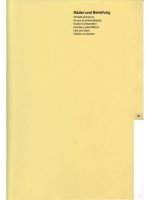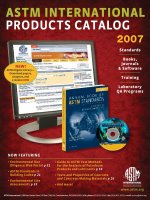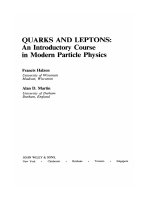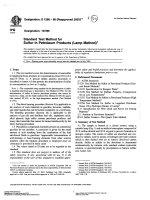Astm stp 844 1984
Bạn đang xem bản rút gọn của tài liệu. Xem và tải ngay bản đầy đủ của tài liệu tại đây (3.64 MB, 238 trang )
METHODS FOR
ASSESSING THE
STRUCTURAL RELIABILITY
OF BRITTLE MATERIALS
A symposium
sponsored by
ASTM Committee E-24
on Fracture Testing
San Francisco, Calif., 13 Dec. 1982
ASTM SPECIAL TECHNICAL PUBLICATION 844
Stephen W. Freiman, National Bureau of
Standards, and C, Michael Hudson,
NASA Langley Research Center, editors
ASTM Publication Code Number (PCN)
04-844000-30
1916 Race Street, Philadelphia, Pa. 19103
#
Copyright by ASTM Int'l (all rights reserved); Wed Dec 23 18:11:39 EST 2015
Downloaded/printed by
University of Washington (University of Washington) pursuant to License Agreement. No further reproductions authorize
Librarj of Congress Cataloging in Publication Data
^4elhllds for assessing the structural rcliahilitv of
brittle materials.
(AS IM special lechnical publication; 844)
-ASTM publication code number (PCN) 04-844000-30.•'
Includes bibliographies and index.
I. Fracture mechanics—Congresses. 2. Brittleness—
Congresses. 3. Ceramic materials—Congresses. I. Freiman. S. W. II. Hudson, C. M. III. A S I M Committee F-24
on Fracture I'esting. IV. Series.
TA409.M4b l%4"
620.1'126
8,3-7,1253
ISBN 0-803l-02b5-8
C o p y r i g h t (?) b y AMEI^ICAN SOCII-MY POK T E S I I N G AND MArEKLA[.,s
1984
Library of C o n g r e s s C a t a l o g C a r d N u m b e r : 83-73253
NOTE
The Society is not responsible, as a body.
for the statement.s and opinions
advanced in this publication.
;tl in B.iliinuirc. Md, (b)
Ociober l')«4
Copyright by ASTM Int'l (all rights reserved); Wed Dec 23 18:11:39 EST 2015
Downloaded/printed by
University of Washington (University of Washington) pursuant to License Agreement. No further reproductions auth
Foreword
The symposium on Methods for Assessing the Structural Reliability of Brittle Materials was held on 13 Dec. 1982 in San Francisco. Calif. The event was
sponsored by ASTM Committee E-24 on Fracture Testing. Stephen W.
Freiman. National Bureau of Standards, and C. Michael Hudson, NASA
Langley Research Center, presided as chairmen of the symposium and also
ser\'ed as editors of this publication.
Copyright by ASTM Int'l (all rights reserved); Wed Dec 23 18:11:39 EST 2015
Downloaded/printed by
University of Washington (University of Washington) pursuant to License Agreement. No further reproductions auth
Related
ASTM Publications
Fractography of Ceramic and Metal Failures, STP 827 (1984), 04-827000-30
Fracture Mechanics for Ceramics, Rocks, and Concrete, STP 745 (1981).
04-745000-30
Fractography and Materials Science, STP 733 (1981), 04-733000-30
Fracture Mechanics Applied to Brittle Materials (11th Conference), STP 678
(1979), 04-678000-30
Copyright by ASTM Int'l (all rights reserved); Wed Dec 23 18:11:39 EST 2015
Downloaded/printed by
University of Washington (University of Washington) pursuant to License Agreement. No further reproductions auth
A Note of Appreciation
to Reviewers
The quality of the papers that appear in this pubHcation reflects not only the
obvious efforts of the authors but also the unheralded, though essential, work
of the reviewers. On behalf of ASTM we acknowledge with appreciation their
dedication to high professional standards and their sacrifice of time and effort.
ASTM Committee on Publications
Copyright by ASTM Int'l (all rights reserved); Wed Dec 23 18:11:39 EST 2015
Downloaded/printed by
University of Washington (University of Washington) pursuant to License Agreement.
No
further
rep
ASTM Editorial Staff
Janet R. Schroeder
Kathleen A. Greene
Rosemary Horstman
Helen M. Hoersch
Helen P. Mahy
Allan S. Kleinberg
Susan L. Gebremedhin
Copyright by ASTM Int'l (all rights reserved); Wed Dec 23 18:11:39 EST 2015
Downloaded/printed by
University of Washington (University of Washington) pursuant to License Agreement. No further reproductions authorize
Contents
Introduction
1
Failure from Contact-Induced Surface Flaws—DAVID B. MARSHALL
3
Controlled Indentation Flaws for Construction of Toughness and
Fatigue Master Maps^ROBERT F. COOK AND BRIAN R. LAWN
22
Fatigue Properties of Ceramics with Natural and Controlled Flaws:
A Study on Alumina—ARMANDO C. GONZALEZ,
HEIDI M U L T H O P P , ROBERT F. COOK, BRIAN R. LAWN, AND
STEPHEN W. FREIMAN
43
Statistical Analysis of Size and Stress State Effects on the Strength
of an Alumina Ceramic—D. K. SHETTY, A. R. ROSENFIELD,
AND W. H. DUCKWORTH
57
Dynamic and Static Fatigue of a Machinable Glass Ceramic—
MATTHEW B. MAGIDA, KATHERINE A. FORREST, AND
THOMAS M. HESLIN
81
Effect of Multb«gion Crack Growth on Proof Testing—
SHELDON M. WIEDERHORN, STEPHEN W. FREIMAN,
EDWIN R. FULLER, JR., AND HERBERT RICHTER
95
Discussion
116
Fracture Mechanics Analysis of Defect Sizes—GERALD G. TRANTINA
117
Effect of Temperature and Humidity on Delayed Failure of Optical
Glass Fibers—JOHN E . RITTER, JR., KARL JAKUS, AND
ROBERT C. BABINSKI
131
Discussion
141
Subthreshold Indentation Flaws in the Study of Fatigue Properties
of Ultrahigh-Strength Glass—TIMOTHY P. DABBS,
CAROLYN J. FAIRBANKS, AND BRIAN R. LAWN
142
Lifethne Prediction for Hot-Pressed Silicon Nitride at High
Temperatures—THEO FETT AND DIETRICH MUNZ
Copyright
Downloaded/printed
University
by
ASTM
154
Int'l
(al
by
of
Washington
(University
Static Fatigue in High-Performance Ceramics—GEORGE D. QUINN
177
Requiiements for Flexure Testing of Brittle Materials—
FRANCIS I. BARATTA
194
Summary
223
Index
227
Copyright
Downloaded/printed
University
by
by
of
STP844-EB/Oct. 1984
Introduction
How can we ensure that ceramic components designed for gas turbine engines, human prostheses, optical communication lines, and many other varied
applications will survive the in-service stresses imposed on them? This symposium on Methods for Assessing the Structural Reliability of Brittle Materials
was organized under the auspices of two subcommittees of ASTM Committee
E-24 on Fracture Testing—Subcommittee E24.06 on Fracture Mechanics Applications and Subcommittee E24.07 on Fracture Toughness of Brittle Nonmetallic Materials—for the purpose of providing a forum for discussion of current and proposed procedures for using fracture mechanics data in the design
of structures made from essentially brittle materials.
One of the major concerns in the development of new ceramic components is
a lack of knowledge regarding the nature of the flaws that can ultimately lead
to failure. Many of the papers in this volume address this question, as well as
the question of the extent to which data obtained on large cracks in fracture
mechanics specimens can be used to predict the behavior of "real" flaws. The
use of crack growth rate data in lifetime prediction and proof-test schemes is
also emphasized.
The field of structural reliability prediction is a fast-moving one. Even as
this book goes to print, the methods of data acquisition and analysis are being
further refined. Nevertheless, the editors feel that this volume provides a very
useful compilation of papers describing the current state of the science in this
field.
Stephen W. Freiman
National Bureau of Standards, Washington,
D.C. 20234; symposium chairman and
editor.
C. Michael Hudson
NASA Langley Research Center, Hampton,
Va. 23665; symposium chairman and editor.
Copyright
by
ASTM
Downloaded/printed
by
Copyright 1984 b y A S I M International
University
of
Washington
Int'l
(all
www.astm.org
(University
rights
of
reserved);
Washington)
Wed
pursuant
David B. Marshall^
Failure from Contact-Induced
Surface Flaws
REFERENCE: Marshall, D. B., "FaUure from Contact-Induced Surface Flaws," Methods for Assessing the Structural Reliability of Brittle Materials, ASTM STP 844, S. W.
Freiman and C. M. Hudson, Eds., American Society for Testing and Materials, Philadelphia, 1984, pp. 3-21.
ABSTRACT: The scattering of acoustic waves by surface cracks is used in ceramics as
both a method of nondestructive evaluation and a means of investigating the mechanics
of failure from surface damage. Initially, experiments combining acoustic scattering, in
situ optical observations, and fracture surface observations of controlled indentation
flaws provide essential insight into the scattering process and the mechanics of failure.
With more complex flaw configurations, such as machining damage, acoustic scattering
measurements provide a unique method for examining the micromechanics of failure and
thereby establishing a basis for strength prediction. The results indicate important differences between indentation flaws and ideal stress-free flaws, both in their response to applied loading and in their acoustic scattering characteristics. The differences are due to
the influence of residual stresses associated with indentation flaws. Machining-induced
cracks behave similarly to indentation cracks. A basis for failure prediction from acoustic
scattering measurements can be established for indentation cracks and machining cracks
but not for ideal stress-free flaws.
KEY WORDS: failure, strength, machining, scratching, indentation, residual stress,
nondestructive testing, acoustic scattering, fractography, structural reliability, brittle
materials
Valuable insight into the mechanism of failure from surface flaws in brittle
materials has been provided by studies of idealized model flaw systems produced by indentation (for example, Vickers or Knoop). These studies have
demonstrated that residual stresses are generated by any mechanical contact
damage involving irreversible deformation. The residual stresses dominate the
cracking associated with the contact during both crack formation and subsequent loading of the cracks to failure. Consequently, the strength of a dam'Research engineer. Structural Ceramics Group, Rockwell International Science Center,
Thousand Oaks, Calif. 91360.
Copyright
by
ASTM
Downloaded/printed
by
Copyright 1984 b y A S I M International
University
of
Washington
Int'l
(all
www.astm.org
(University
rights
of
reserved);
Washington)
Wed
pursuant
4
STRUCTURAL RELIABILITY OF BRITTLE MATERIALS
aged surface is not related exclusively to the size of the largest crack produced
by the damage, as in the conventional view of failure; rather the strength is dictated by the residual stresses, which are determined by the contact parameters
(load, geometry) and the elastic/plastic response of the material during the
contact event. Detailed fracture mechanics analyses for indentation cracking
have been developed and verified experimentally by direct observations of flaw
response [1-5].
Application of the residual stress concepts derived for isolated indentation
flaws to more complex configurations such as machining damage has been
demonstrated by observing the scattering of surface acoustic waves from the
cracks associated with the damage. In addition to providing a method for identifying the existence of residual stresses and their dominant role in the failure
process, the acoustic scattering experiments establish the basis for a method of
nondestructive strength prediction.
The main purposes of this paper are to review the current understanding of
the mechanisms of failure from contact-induced surface flaws, with particular
emphasis on the damage generated by multipoint surface grinding, and to assess the feasibility of nondestructive evaluation using the scattering of acoustic
waves. In addition, some new measurements of surface residual stresses
associated with machining damage will be presented.
Isolated Cracks
Mechanics of Failure
The importance of residual stresses in the contact-induced cracking of brittle surfaces is readily demonstrated by observing crack evolution during the
controlled loading and unloading of well-defined indenters on optically transparent materials. For sharp indenters such as the Vickers or Knoop, the final
crack configurations (Fig. 1) are achieved as the indenter is removed from the
surface [1,3], thus establishing that the driving force for crack formation is
provided by a residual stress field. Moreover, since the residual field persists
after the contact event, it must supplement any applied loading in driving the
cracks to failure. The existence of a postindentation crack-opening force has
also been demonstrated by observations of subcritical extension of indentation
cracks after indenter removal in materials that are susceptible to environmentally assisted slow crack growth [5,6].
Determination of the stress intensity factor, K^, due to the residual field is
central to any fracture mechanics analysis involving indentation cracks. The
residual field results from the elastic/plastic nature of the deformation beneath the indenter and may be evaluated in terms of an outward-acting pressure at the boundary of the plastic zone [1,3], For approximately axisymmetric
indenters, such as the Vickers pyramid, the plastic zone occupies an almost
hemispherical volume centered beneath the indentation (Fig. 1, bottom). If
Copyright by ASTM Int'l (all rights reserved); Wed Dec 23 18:11:39 EST 2015
Downloaded/printed by
University of Washington (University of Washington) pursuant to License Agreement. No further reproductions authoriz
MARSHALL ON FAILURE FROM CONTACT-INDUCED SURFACE FLAWS
5
,J^
210 Mm
Lateral /
Crock ,
Radial
Crack
.
/
FIG. 1—(Top) Wickers indentation in zinc sulfide (ZnS). (Bottom) Schematic cross section of
the indentation, showing the deformation zone and fractures.
Copyright by ASTM Int'l (all rights reserved); Wed Dec 23 18:11:39 EST 2015
Downloaded/printed by
University of Washington (University of Washington) pursuant to License Agreement. No further reproductions authoriz
STRUCTURAL RELIABILITY OF BRITTLE MATERIALS
the crack dimension (c) is sufficiently large compared with the plastic zone
radius (b) the pressure may be treated as a point force located at the crack center. Under this condition, a straightforward solution for the stress intensity
factor for the radial crack has been derived [1,3]
(1)
Kr = ^3/2
where P is the indeiiter load and Xr ~ %{E/Hy^, with E and H the elastic
modulus and hardness of the material and § a dimensionless constant dependent only on indenter geometry. The crack dimension, CQ, after indentation is
obtained by equating K^ to the material toughness, Kc, in Eq 1
co =
XrL
2/3
K,
(2)
The validity of Eq 2 has been tested with Vickers indentation in a wide range of
ceramic materials [S\?
The mechanics of failure from radial cracks under the combined influences
of the residual stress and a normal applied tension,CT^,has been analyzed in
detail [2,4,7]. The crack response is described by an applied-stress/equilibrium-crack-size function
K^
_ (irUc) 1/2
1-
(3)
(where Q is a crack geometry parameter), which is obtained by superimposing
the stress intensity factors due to the residual and applied fields {K^ from Eq 1
and/Ta =CT„(irnc)'''2)and setting/iir -'r Ka = Kc for equilibrium crack extension. The failure condition is defined by the maximum in the (7„(c) function
Cm
=
"m —
( ^Xr"
\
^2/3
27
Ki
' 1/3 / J - 1 / 3
_ 256 xMQ?'^ _
3K,
4(7rfic„)i^2
(4)
(5a)
(5b)
This analysis requires that the crack dimensions be large compared with the scale of any microstructure. For example, in large-grained polycrystalline ceramics the fracture resistance becomes dependent on crack length and orientation, resulting in severe disruption of the ideal
crack pattern of Fig. 1 [5].
Copyright by ASTM Int'l (all rights reserved); Wed Dec 23 18:11:39 EST 2015
Downloaded/printed by
University of Washington (University of Washington) pursuant to License Agreement. No further reproductions authorized.
MARSHALL ON FAILURE FROM CONTACT-INDUCCD SURFACE FLAWS
7
and failure is preceded by stable equilibrium crack growth from CQ to c^. This
behavior contrasts with the response of ideal, stress-free cracks, where crack
instability is achieved at a critical applied stress level without precursor extension (xr = 0, c = Co in Eq 3).
The indentation fracture analysis has also been extended to the linear deformation fracture configuration [8,9]. The analysis predicts a similar crack response under applied load, although the region of stable precursor crack
growth is more extensive (C^/CQ = 4) than for axisymmetric penetration
(c^/co = 2.5). The linear-damage analysis applies strictly to cracks generated
by the penetration of a wedge indenter. However, the observations by Rice and
Mecholsky [10], of semielliptical (rather than linear) cracks beneath scratches
and machining grooves (see also the section on Machining Damage) suggest
that loading during machining may resemble more closely axisymmetric indentation. Such geometrical deviations from linear geometry would be expected to reduce the ratio C^/CQ.
Observations of Crack Response
Optical Observations—In situ measurements of surface traces of indentation cracks during failure testing (Fig. 2a) have confirmed the existence of stable precursor crack extension according to Eq 3 in a wide variety of ceramic materials (glass [2], silicon [//], glass ceramics [12], and silicon nitride [4,13]).
Extensive measurements have been obtained in silicon nitride at various contact loads and indenter geometries [4,13]. The data were presented on a universal plot (Fig. 2b) by expressing Eq 3 in terms of normalized variables 5 = ffa/a„,
and C = c/c„,, so that the parameters describing indenter geometry and contact load do not appear explicitly
-(l)^""X-(i)0
The crack growth curves for two very different indenter geometries (Vickers
and Knoop) are coincident, and both are close to the predicted curve,-' thus illustrating that Eq 3 applies to a wide range of contact configurations.
Acoustic Scattering Observations—The occurrence of stable crack extension prior to failure from contact-induced flaws provides a convenient indication of the existence of residual crack-opening stresses. For indentation cracks,
optical observation of radial surface traces, during load application, has confirmed the expected crack response. However, optical observation of cracks in
more general damage configurations such as machining is not always possible.
^The increase of crack length with applied stress becomes rapid as a approaches (j„. Confirmation that all of the data in Fig. 2b represent stable equilibrium cracks was obtained by directly observing the cracks while the applied stress was held constant at each measurement
point.
Copyright by ASTM Int'l (all rights reserved); Wed Dec 23 18:11:39 EST 2015
Downloaded/printed by
University of Washington (University of Washington) pursuant to License Agreement. No further reproductions authorized.
8
STRUCTURAL RELIABILITY OF BRITTLE MATERIALS
to
-t
•
I . . .
• \ * -
.a
ãô
ã
1
ããã
ã'ã
. . .
I
'^ãO'f^.
Copyright by ASTM Int'l (all rights reserved); Wed Dec 23 18:11:39 EST 2015
Downloaded/printed by
University of Washington (University of Washington) pursuant to License Agreement. No further reproduction
MARSHALL ON FAILURE FROM CONTACT-INDUCED SURFACE FLAWS
1
200 N
1.0 -
«» 0.5 -
m
9
1
SON
A Vickers
•
Knoop
^JU
•/
I,
Normalized
0.5
Crock Length, c/c„
1.0
FIG. 2b—Surface trace measurements of stable crack extension during breaking test: Si^N^
bars were indented with Vickers or Knoop indenters and broken in bending (after Ref 4).
In these cases techniques of crack detection based on the scattering of acoustic
waves [14] provide a means of monitoring crack response and thereby determining the influence of residual stresses.
An acoustic scattering technique designed specifically for the detection of surface cracks [15] is illustrated in Fig. 3; transducer 1 excites surface (Rayleigh)
waves incident nearly normal to the crack surface, and transducer 2 detects
the backscattered waves. The relative amplitude of the backscattered signal
is related, by means of scattering analysis, to the crack dimensions, whereas
the time delay between the generation and the receiving of the signal defines
the crack position.
The acoustic scattering from surface cracks is related uniquely to the crack
area, provided the crack surfaces are separated. However, the scattering is
sensitive to the existence of crack closure effects. This sensitivity is demonstrated by comparing the acoustic scattering from an indentation crack and
an initially stress-free crack'' of similar dimensions (Fig. 4a). Optical observations confirmed that the stress-free crack did not extend prior to failure.
However, the reflected acoustic signal (expressed in Fig. 4a in terms of a
calculated crack radius, assuming an open, surface half-penny crack [16])
shows a reversible increase with applied load. This increase was interpreted in
"•The stress-free crack was obtained by removing the plastic zone (and therefore the residual
stress) of an indentation crack by mechanical polishing. Similar acoustic scattering results have
also been obtained from cracks which had the residual stress eliminated by annealing 1/5).
Copyright by ASTM Int'l (all rights reserved); Wed Dec 23 18:11:39 EST 2015
Downloaded/printed by
University of Washington (University of Washington) pursuant to License Agreement. No further reproductions auth
10
STRUCTURAL RELIABILITY OF BRITTLE MATERIALS
FIG. 3—The acoustic scattering and mechanical loading configurations used for monitoring
crack growth during failure testing: Ag = amplitude of wave excited by transducer 1; A, = amplitude of scattered wave received by transducer 2: F = applied bending force (after Ref \1).
terms of a reversible opening and closing of the crack surfaces under the applied loading [75]. At zero applied stress, complete crack closure is prevented
by contacts at asperities over the crack surface. The areas between the contacts scatter as small open cracks of area^l, but, since the scattered amplitude
from each open area is approximately proportional to Af^ the total scattered
amplitude is considerably smaller than that of a fully open crack. Applied tension relieves the contacts continuously until, at the failure point, the crack
faces are fully separated and the true crack radius is measured (compare the
optical crack length measurement. Fig. Aa).
Acoustic scattering from indentation cracks (which are subject to residual
crack opening) does not show the reversible opening and closing effects (Fig.
4Z>). However, an irreversible increase in acoustic signal with applied tension,
corresponding to genuine stable crack extension, is detected. Despite some
complication in modeling the crack geometry for acoustic scattering analysis,^
a true measure of the crack dimension is obtained at all stages during the failure test. Comparison of acoustic measurements, optical measurements, and
fracture mechanics predictions (Eq 3) are shown in Fig. 4c. The irreversibility
of the acoustic scattering response with applied loading provides a definitive
indication of the presence of residual crack opening stresses.
The responses of two linear isolated damage configurations (row of indentations, scratch) have also been investigated [17\. An irreversible increase in
scattered intensity was observed in both cases, thus indicating the existence of
stable precursor crack extension due to residual stresses.
*The crack does not penetrate the plastic zone; therefore, the crack exhibits the geometry of a
semiannulus with inner radius dictated by the plastic zone radius. Calculations based on a subsurface elliptical crack have provided a good approximation [tS\.
Copyright by ASTM Int'l (all rights reserved); Wed Dec 23 18:11:39 EST 2015
Downloaded/printed by
University of Washington (University of Washington) pursuant to License Agreement. No further reproductions
MARSHALL ON FAILURE FROM CONTACT-INDUCED SURFACE FLAWS
1
Residual Stress Eliminated
300
1
11
1
by Surface Removal
m •
A
•
A
A
AE
:20o ~"
—
•
•o
a>
"Q.
d
<
••^
100 —
o
'*••
Loading
^ o Unloading
_
*°
o
0
s
0
•
Crack lengtti
meosured optically
1
1
1
1
1
0
50
100
150
Crack Length Calculated from Acoustic Signal, /im
FIG. 4a—Variation of acoustic scattering, from indentation cracks in polished surfaces of
Si^jN^, during tensile loading: stress-free crack. Note the reversible increase in acoustic scattering /expressed as crack length calculated for an open half-penny surface crack) with applied tension.
Fracture Surface Observations—In some materials the regions of stable
and unstable crack extension can be distinguished in optical observations of
the fracture surface. The distinction arises from changes in fracture morphology [17\ (for example, transgranular to intergranular) or from small perturbations in the plane of propagation [1]. The fracture surface of a Knoop indentation crack in Si3N4 is shown in Fig. 5. The reflectivity (brightness) is high in
the regions of crack formation and postfailure extension but low in the intermediate region of stable crack growth during loading.
The fracture surface for a row of Knoop indentation cracks in Si3N4 is
shown in Fig. 6. Under the influence of the applied tension, some of the
cracks coalesced and extended stably to an elongated semielliptical surface
crack configuration at failure. Similar crack configurations were observed on
fracture surfaces resulting from scratch-induced failures [17\. The identification of stable precursor crack grovrth is consistent with the acoustic scattering
results.
Copyright by ASTM Int'l (all rights reserved); Wed Dec 23 18:11:39 EST 2015
Downloaded/printed by
University of Washington (University of Washington) pursuant to License Agreement. No further reproductions authorized.
12
STRUCTURAL RELIABILITY OF BRITTLE MATERIALS
1
I
As -Indô nfed
^J""**
"
o 200
'^
'
0
ã
ã
S
ão
ãã
-
ã o
o
tfT
(A
ôi
w
ão
ã
(7)
ão
ão
0
ô
a 100
•
•
o
o
•
•o
c
0
Loading
'^ Unloading
•o
•o
0
0
n
1
1
1.0
Acoustic
2.0
Signal
FIG. 4A—Knoop indentation crack (50-N load). Note the irreversible increase in acoustic
scattering.
1
1
1
1
fis-Indented
1.0-
.8**"*
J
ã
ã
đ 0.5
ã
0
0
oto
~~
y^
Fracture Mechanics
Prediction
/
-
o/
o Acoustic measurement
ã Optjcol meosurement
ã (J
A
1.0
1
1
2.0
Crack Length, C/CQ
1
3.0
FIG. 4c—Knoop indentation crack (50-N load): comparison of acoustic measurements, insitu optical measurements, and fracture mechanics prediction of the variation of crack length
with applied tension (after Ref \1).
Copyright by ASTM Int'l (all rights reserved); Wed Dec 23 18:11:39 EST 2015
Downloaded/printed by
University of Washington (University of Washington) pursuant to License Agreement. No further reproductions
MARSHALL ON FAILURE FROM CONTACT-INDUCED SURFACE FLAWS
13
2C m
h—2Co -Hj
FIG. 5—Fracture surfaces in SijN^ (width of field 830 fim): (Top) Knoop indentation (50-N
load) in a polished surface (specimen from Fig. 4h). (Bottom) Knoop indentation (50-N load) in
a machined surface (after Ref \1).
Machining Damage
Observations of Crack Response
With the acoustic scattering setup of Fig. 3, separate reflected signals were
obtained from the cracks associated with the major grooves on machined surfaces of Si3N4 [17\. The variation of acoustic scattering from the strengthcontrolling crack during a failure test is shown in Fig. 7. The irreversible increase in scattered intensity indicates that a residual crack-opening stress
Copyright by ASTM Int'l (all rights reserved); Wed Dec 23 18:11:39 EST 2015
Downloaded/printed by
University of Washington (University of Washington) pursuant to License Agreement. No further reproductions au
14
STRUCTURAL RELIABILITY OF BRITTLE MATERIALS
Surface
damage layer
Initial
machining
cracks ' Crack front at instability
FIG. 6—(Top) Fracture surface resulting from a row of indentations (50-N load) on a polished
surface of SijN4. The width of the field is 2.8 mm. (Bottom) Schematic representation of crack
configurations generated by linear damage processes (row of indentations, scratching, or machining) and the crack front at failure (after Ref M).
caused stable crack growth during loading. This conclusion was supported by
fracture surface observations, which showed crack configurations very similar
to those in Fig. 6 (due to a row of indentations) with a clearly identifiable row
of cracks beneath the grinding groove and a region of stable crack growth.
Thus, the response of the strength-controlling cracks in a machined surface
appears to follow closely the response of cracks in isolated linear damage configurations. However, the strength of a machined surface is also influenced by
the overlap of residual stress fields due to neighboring machining grooves.
Influence of Multiple Grinding Grooves
An isolated grinding groove (or indentation) is surrounded by a plastic
zone, which accommodates the volume of the groove (Fig. 1, bottom). The
residual stress, which can be evaluated in terms of an outward-acting pressure
at the boundary of the plastic zone [2], creates compression adjacent to, and
within, the zone and tension on median planes beneath the zone. The cumulative effect of many neighboring damage sites of similar depths, and with a
high degree of overlap in their residual fields, would be the development of a
uniform thin layer of residual compression (to the depth of the plastic zones)
and an underlying residual tension of relatively low magnitude. However, the
strength-controlling damage in a machined surface is expected to extend to a
greater depth than the average damage in neighboring regions. Thus, the upper portion of the outward-acting pressure from the strength-controlling
groove might be negated by a surrounding layer of residual compression from
Copyright by ASTM Int'l (all rights reserved); Wed Dec 23 18:11:39 EST 2015
Downloaded/printed by
University of Washington (University of Washington) pursuant to License Agreement. No further reproductions authori
MARSHALL ON FAILURE FROM CONTACT-INDUCED SURFACE FLAWS
15
300
eoo
100
•
Loading
O Unlooding
Acoustic
Signal
FIG. 7—Variation of acoustic scattering with applied tension for the strength-controlling flaw
in a machined surface of SijN^ (after Ref \1).
neighboring grooves, but the opening force associated with the lower portion
persists [17\.
The existence of a compressive surface layer in a machined surface was first
demonstrated by Cook et al [18], by measuring the strengths of glass ceramic
flexure bars with indentation cracks introduced into polished and machined
surfaces. At identical indentation loads the machined surfaces exhibited
higher strengths than the polished surfaces. Similar experiments have been
done with scratches and rows of indentations in polished and machined surfaces of Si3N4 [17\. In all cases the strength of the machined surface was
higher than that of the polished surface subjected to the equivalent strengthcontrolling contact damage. The strength increase was consistently higher for
transversely machined bars than for longitudinally machined bars, indicating
that the compression is higher in the direction normal to the machining
grooves. The strength increase is also sensitive to the size of the strengthcontrolling flaw in relation to the depth of the machining damage, the largest
increase (310 to 530 MPa) being observed for the smallest strength-controlling
flaws.
Although a residual compression capable of increasing the strength of a
given contact damage by up to 70% has been identified in machined surfaces,
it must be emphasized that it is the localized residual tension that exerts a
dominating influence on the strength-controlling flaw. This is illustrated in
Fig. 5, where the fracture surfaces from Si3N4 flexure bars with Knoop inden-
Copyright by ASTM Int'l (all rights reserved); Wed Dec 23 18:11:39 EST 2015
Downloaded/printed by
University of Washington (University of Washington) pursuant to License Agreement. No further reproductions authorized
16
STRUCTURAL RELIABILITY OF BRITTLE MATERIALS
tations in polished (Fig. 5, top) and machined (Fig. 5, bottom) surfaces are
compared. In both cases stable crack growth preceded failure (also confirmed
by in-situ acoustic scattering measurements) [17], indicating that a residual
opening stress existed. However, both the initial crack length, CQ, and the extent of stable crack growth, c„^ (measured along the surface), are smaller for
the machined specimen than for the polished specimen. These observations
are consistent with the higher strength measured in the machined specimen
(290 MPa compared to 240 MPa).
Measurement of Residual Compression
A quantitative measure of the residual compressive surface layer can be obtained from the degree of elastic bending caused by the layer in a thin plate.
The measurement is obtained by first preparing a flat polished surface on one
side of a thick plate, and then bonding the polished surface to a rigid support
base and reducing the thickness of the plate by machining from the opposite
surface. When the plate is removed from the support base, the compression in
the machined surface causes the plate to bend so that the polished surface becomes concave (Fig. 8, top). Measurement of the radius of curvature, p, by
optical interference methods allows the product of the average compression,
(j/{, and the thickness, t, of the layer to be evaluated from the relation [19]
ORt = -r-Z
T
6 p ( l — V)
(7)
where d is the thickness of the plate {d » t), E is the elastic modulus, and v
the Poisson's ratio.
An optical interference micrograph of a thin plate of Si3N4 prepared in this
manner is shown in Fig. 8 (bottom). The elliptical shape of the interference
rings indicates that the compression is not equi-biaxial; the compression is
maximum (that is, radius of curvature, p, is minimum) normal to the machining direction, in agreement with the imphcation of the strength measurements
discussed in the previous section. From Fig. 8 (bottom) we obtain p = 2.2 m
parallel to the machining direction and p — 1.4 m normal to the machining
direction.^ Then, with d = 0.340 mm, E = 300 GPa and v = 0.25, Eq 7 yields
ojft — 3.5 X 10^ Pa-m parallel to the machining direction and ant — 5.5 X
10-' Pa • m normal to the machining direction.^
^Similar optical interference measurements prior to the machining step indicated that any deviation of the polished surface from perfect flatness was negligible ( < 1 jim).
^Equation 7 applies to uniform, equi-biaxial compression. However, the corresponding expression for uniaxial compression in a beam differs from Eq 7 by only a factor of 1 — v). Therefore, the error in the present calculations due to the application of Eq 7 to unequal biaxial compressions is expected to be small.
Copyright by ASTM Int'l (all rights reserved); Wed Dec 23 18:11:39 EST 2015
Downloaded/printed by
University of Washington (University of Washington) pursuant to License Agreement. No further reproductions authorize
MARSHALL ON FAILURE FROM CONTACT-INDUCED SURFACE FLAWS
17
FIG. 8—(Top) Thin plate ofSijN^ (thickness is 0.1 mm) with the upper surface polished (initially Jlat) and the lower surface subsequently machined. (Bottom) Optical interference photograph of the polished surface of a plate similar to that above (thickness is 0.34 mm). The machining direction on the lower surface is horizontal. The wavelength of illumination is 546 nm:
the width offield. 10.7 mm.
Evaluation of an requires a measurement of the thickness of the compressive layer. This could be obtained directly by measuring the change of p with
removal of the machining damage by polishing, etching, or ion milling. However, in the absence of such measurements, a preliminary estimate of t is obtained here from measurements of plastic zone depths in controlled indentation experiments. For Knoop indentation in Si3N4 the plastic zone depth was
found to be approximately equal to the width of the residual contact impression [20]. In other experiments [17], & scratch produced by dragging a Knoop
indenter across a Si3N4 surface, under a normal load of 5 N, left a track of
«10 ixm. width and degraded the strength by about the same amount as the
machining damage. Therefore, if we assume that the ratio of plastic zone
depth to contact width is about the same for sliding and stationary Knoop indentation, the depths of the plastic zones associated with the 5 N Knoop
scratch and the strength-controlling machining groove are both «10 /xm.
Taking this as an upper bound estimate for t, the average compressive stresses
become a^ > 350 MPa parallel to the machining grooves and «TR > 550 MPa
normal to the machining grooves. Notwithstanding the uncertainty in the
Copyright by ASTM Int'l (all rights reserved); Wed Dec 23 18:11:39 EST 2015
Downloaded/printed by
University of Washington (University of Washington) pursuant to License Agreement. No further reproductions auth
